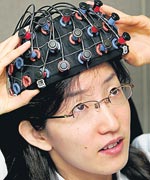
Move the train with your brainHATOYAMA, Japan, Saturday (AP) - Forget the TV remote: A new technology in Japan could let you control electronic devices without lifting a finger simply by reading brain activity. The ''brain-machine interface'' developed by Hitachi Inc. analyzes slight changes in the brain's blood flow and translates brain motion into electric signals.
A cap connects by optical fibers to a mapping device, which links, in turn, to a toy train set via a control computer and motor during one recent demonstration at Hitachi's Advanced Research Laboratory in Hatoyama, just outside Tokyo. ''Take a deep breath and relax,'' said Kei Utsugi, a researcher. At his prompting, I did simple calculations in my head, and the train sprang forward _ apparently indicating activity in the brain's frontal cortex, which handles problem solving. Activating that region of the brain — by doing sums or singing a song — is what makes the train run, according to Utsugi. When I then stopped the calculations, the train stopped, too. Underlying Hitachi's brain-machine interface is a technology called optical topography, which sends a small amount of infrared light through the brain's surface to map out changes in blood flow. Although brain-machine interface technology has traditionally focused on medical uses, makers like Hitachi and Japanese automaker Honda Motor Co. have been racing to refine the technology for commercial application. Hitachi's scientists are set to develop a brain TV remote controller letting users turn a TV on and off or switch channels by only thinking. Honda, whose interface monitors the brain with an MRI machine like those used in hospitals, is keen to apply the interface to intelligent, next-generation automobiles. The technology could one day replace remote controls and keyboards and perhaps help disabled people operate electric wheelchairs, beds or artificial limbs. Initial uses would be helping people with paralyzing diseases communicate even after they have lost all control of their muscles. Since 2005, Hitachi has sold a device based on optical topography that monitors brain activity in paralyzed patients so they can answer simple questions — for example, by doing mental calculations to indicate ''yes'' or thinking of nothing in particular to indicate ''no.'' |
|| Front
Page | News | Editorial | Columns | Sports | Plus | Financial
Times | International | Mirror | TV
Times | Funday
Times || |
| |
Copyright
2007 Wijeya
Newspapers Ltd.Colombo. Sri Lanka. |
